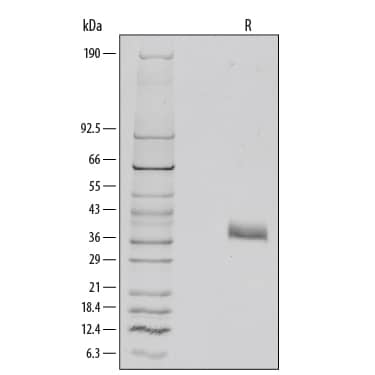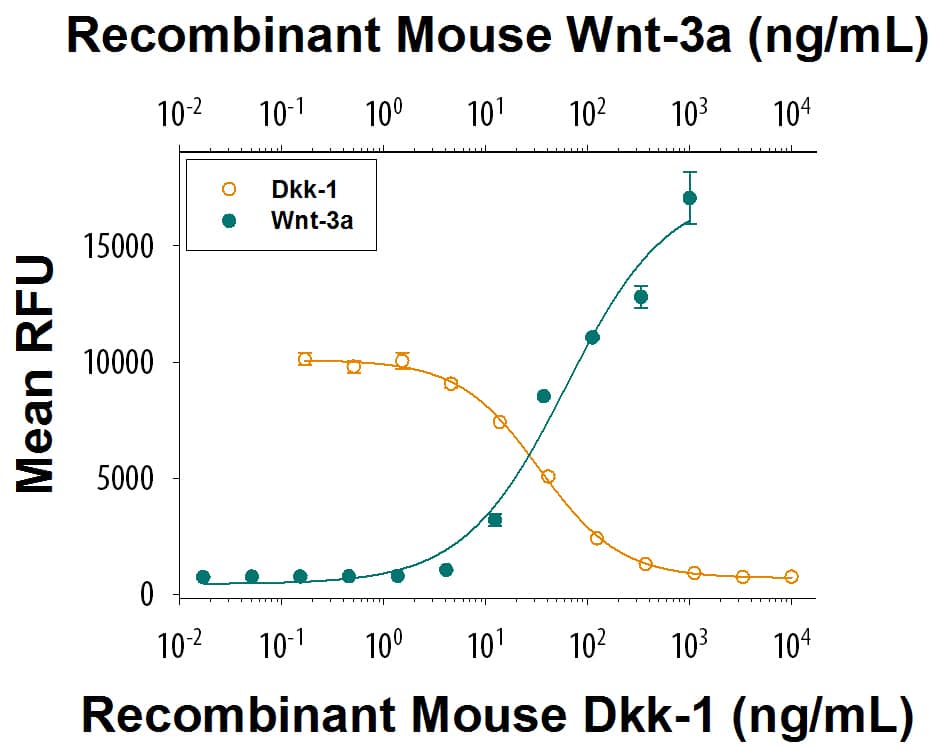Recombinant Mouse Dkk-1 Protein
R&D Systems, part of Bio-Techne | Catalog # 5897-DK

Key Product Details
Product Specifications
Source
Ser30-His272
Purity
Endotoxin Level
N-terminal Sequence Analysis
Predicted Molecular Mass
SDS-PAGE
Activity
Recombinant Mouse Dkk-1 (Catalog # 5897-DK) inhibits a constant dose of 100 ng/mL of Recombinant Mouse Wnt-3a (Catalog # 1324-WN). The ED50 for this effect is 10-60 ng/mL.
Reviewed Applications
Read 4 reviews rated 4.5 using 5897-DK in the following applications:
Scientific Data Images for Recombinant Mouse Dkk-1 Protein
Recombinant Mouse Dkk-1 Protein Bioactivity
Recombinant Mouse Wnt-3a (Catalog # 1324-WN) induces a dose responsive increase in Wnt reporter activity in HEK293 cells (green circles). Recombinant Mouse Dkk-1 (Catalog # 5897-DK) inhibits a constant dose of 100 ng/mL of Recombinant Mouse Wnt-3a. The ED50 for this effect is 10-60 ng/mL (orange circles).Recombinant Mouse Dkk-1 Protein SDS-PAGE
1 µg/lane of Recombinant Mouse Dkk-1 was resolved with SDS-PAGE under reducing (R) conditions and visualized by silver staining, showing major bands at 35-40 kDa. Multiple bands in gel are due to variable glycosylation.Formulation, Preparation and Storage
Carrier Free
What does CF mean?CF stands for Carrier Free (CF). We typically add Bovine Serum Albumin (BSA) as a carrier protein to our recombinant proteins. Adding a carrier protein enhances protein stability, increases shelf-life, and allows the recombinant protein to be stored at a more dilute concentration. The carrier free version does not contain BSA.
What formulation is right for me?In general, we advise purchasing the recombinant protein with BSA for use in cell or tissue culture, or as an ELISA standard. In contrast, the carrier free protein is recommended for applications, in which the presence of BSA could interfere.
Carrier: 5897-DK
| Formulation | Lyophilized from a 0.2 μm filtered solution in PBS with BSA as a carrier protein. |
| Reconstitution | Reconstitute at 100 μg/mL in PBS containing at least 0.1% human or bovine serum albumin. |
| Shipping | The product is shipped at ambient temperature. Upon receipt, store it immediately at the temperature recommended below. |
| Stability & Storage | Use a manual defrost freezer and avoid repeated freeze-thaw cycles.
|
Carrier Free: 5897-DK/CF
| Formulation | Lyophilized from a 0.2 μm filtered solution in PBS. |
| Reconstitution | Reconstitute at 100 μg/mL in PBS. |
| Shipping | The product is shipped at ambient temperature. Upon receipt, store it immediately at the temperature recommended below. |
| Stability & Storage | Use a manual defrost freezer and avoid repeated freeze-thaw cycles.
|
Background: Dkk-1
Dickkopf related protein 1 (Dkk-1) is the founding member of the Dickkopf family of proteins that includes Dkk-1, -2, -3, -4, and a related protein, Soggy (1, 2). Dkk proteins are secreted proteins that contain two conserved cysteine-rich domains separated by a linker region. Each domain contains ten cysteine residues (1-3). Mature mouse Dkk-1 is a 40 kDa glycosylated protein that shares 86%, 96%, 83% and 82% amino acid (aa) sequence identity with human, rat, rabbit and bovine Dkk-1, respectively. It also shares 41% and 36% aa identity with human Dkk-2 and Dkk-4, respectively. Dkk-1 and Dkk-4 are well documented antagonists of the canonical Wnt signaling pathway (1, 2). This pathway is activated by Wnt engagement of a receptor complex composed of the Frizzled proteins and one of two low‑density lipoprotein receptor-related proteins, LRP5 or LRP6 (4). Dkk-1 antagonizes Wnt by forming ternary complexes of LRP5/6 with Kremen1 or Kremen2 (4, 5). Dkk-1/LRP6/Krm2 complex internalization has been shown to down-regulate Wnt signaling (4, 5). Dkk-1 is expressed throughout development and antagonizes Wnt-7a during limb development (6, 7). Other sites of expression include developing neurons, hair follicles and the retina of the eye (8, 9). The balance between Wnt signaling and Dkk-1 inhibition is critical for bone formation and homeostasis (10). Insufficient or excess Dkk-1 activity in bone results in increased or decreased bone density, respectively (8, 11). In adults, Dkk-1 is expressed in osteoblasts and osteocytes, and neurons. Cerebral ischemia induces Dkk-1 expression, which contributes to neuronal cell death (12).
References
- Glinka, A. et al. (1998) Nature 391:357.
- Niehrs, C. (2006) Oncogene 25:7469.
- Bullock, C.M. et al. (2004) Mol. Pharmacol. 65:582.
- Mao, B. et al. (2001) Nature 411:321.
- Mao, B. et al. (2002) Nature 417:664.
- Kemp, C. et al. (2005) Dev. Dyn. 233:1064.
- Adamska, M. et al. (2004) Dev. Biol. 272:134.
- Li, J. et al. (2006) Bone 36:754.
- Verani, R. et al. (2006) J. Neurochem. 101:242.
- Pinzone, J.J. et al. (2009) Blood 113:517.
- Morvan, F. et al. (2006) J. Bone Miner. Res. 21:934.
- Cappuccio, I. et al. (2005) J. Neurosci. 25:2647.
Long Name
Alternate Names
Gene Symbol
UniProt
Additional Dkk-1 Products
Product Documents for Recombinant Mouse Dkk-1 Protein
Product Specific Notices for Recombinant Mouse Dkk-1 Protein
For research use only

